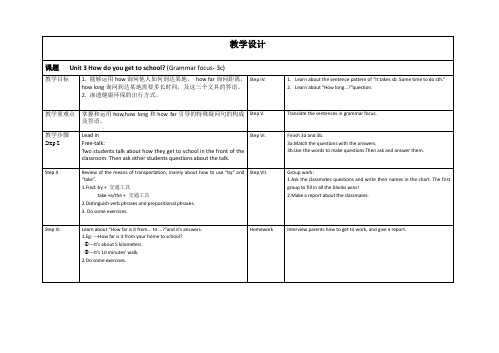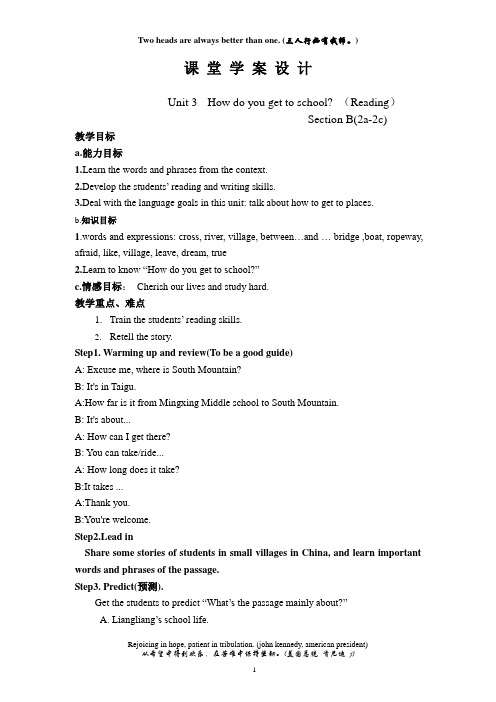人教七年级英语下册《nit 3 How do you get to school: Section A 2e—3c》公开课教案_35
- 格式:docx
- 大小:227.91 KB
- 文档页数:5


Unit 3 How do you get to schoolPeriod 1教学内容与分析教学内容:Make a list ; Listen and write ; Pairkwork教学目标:1) 能够谈论:How do you get to school? 掌握各种交通工具的英语表达法。
2) 能够听、说、认读句子:A:How does Bob get to school? B:He takes the train.3) 能用熟练地运用这些句型对不同交通工具的使用进行谈论和比较。
教学重点、难点分析教学重点:能够听、说、读、写各类交通工具并在实际情景中会运用How do you get to school?句型进行交际活动。
教学难点:take ride the/ a …to + 地点= go to + 地点+ by…walk to +地点= go to + on foot教学设计Teaching proceduresStep ⅠWarming-up and Revision1.Greetings and free talk.2.RevisionStep ⅡLead in1. Listen and guess what it is.Listen and guess what it is. Revise the old words and teach the new words.2. Guessing gameThe teacher say a sentence ask the students to guess what kind of transportation it is.---It is like a bike but goes much faster. ---A motorbike.---It is like a train but goes under the ground. ---A subway.---It goes in the water. ---A ship or a boat.---It takes you about three hours to go to Beijing from Shenzhen by it. ---A plane.---It can take people to the moon. ---A spaceship.---It is very useful, you may ride it to school. ---A bike3. There are so many transportations around the world. What kind of transportation do you like to choose ?Ask how do you get to school/Shanghai/ Hangzhou/ Luqiao /Paris….?Help the students answer:I take the subway./take the bustake a minibus /take a taxitake the train / take the planetake the ship/take the carride my/a bikeride a motorbike/walkStep ⅢTo work in pairs, ask and answerAsk the students to work in pairs.A: How do you get to school?B: I walk to school. I ride a bike to school.I take a bus to school. I take a car to school.I take the subway to school. I take the train to school.Step ⅣPresentation1. First ask two students to ask and answer in pair.Then ask the other students “how does he/she get to school?”He/She takes the subway. /……rides his/her bike……walks.Step ⅤGroup workAsk the students to do group work.A: How do you get to school?B: I take the bus. / ride my bike/ bicycle./ walk.C: How does he /she get to school?He/She takes the bus/… rides his/her bike/bicyc le ./ walks.Step ⅥWork on 1a and 1b.1. To do Section A 1a look at the picture and write down the way of transportation.2. To listen to the tape and finish1b.Step ⅦPresentationAsk “h ow does Bob get to school?’ Help them answer he takes the train.Then ask “how does Paul get to school?” "He walks."Say Paul usually walks to school. He goes to school on foot.Show some pictures to students. Ask them to say like this.My father rides a bike to work every day. =My father goes to work by bike every day. Step ⅧTo work in pairs, ask and answerShow some pictures to the students then ask then to work in pairs.A: How do you get to......? B: I take/ride/walk......I get to school...by.../on...Step ⅨSummaryTake/ride the/a ...to+地点=go to +地点+by....Walk to+地点=go to +on foote.g. He often takes the subway to work.=He often goes to work by subway.注意:当home, here, there 作地点时to 不要。



课堂学案设计Unit 3How do you get to school? (Reading)Section B(2a-2c)教学目标a.能力目标1.Learn the words and phrases from the context.2.Develop the students’ reading and writing skills.3.Deal with the language goals in this unit: talk about how to get to places.b.知识目标1.words and expressions: cross, river, village, between…and … bridge ,boat, ropeway, afraid, like, village, leave, dream, true2.Learn to know “How do you get to school?”c.情感目标:Cherish our lives and study hard.教学重点、难点1.Train the students’ reading skills.2.Retell the story.Step1. Warming up and review(To be a good guide)A: Excuse me, where is South Mountain?B: It's in Taigu.A:How far is it from Mingxing Middle school to South Mountain.B: It's about...A: How can I get there?B: You can take/ride...A: How long does it take?B:It takes ...A:Thank you.B:You're welcome.Step2.Lead inShare some stories of students in small villages in China, and learn important words and phrases of the passage.Step3. Predict(预测).Get the students to predict “What’s the passage mainly about?”A. Liangliang’s school life.B. A small villageC. How do students go to school.Step4. Read and checkSkim the passage and answer the questions.1.How do the students in the village go to school?2.Why do they go to school like this?3.Does the boy like his school ?Why ?Step5. Careful reading.(Underline the words and phrases that are important.)(1). Read Para. 1 and fill in the blanks1.There is a very big river________their school ______ the village.2.There is ____________and the river______too_______for boats. Para.13.These students ______________to ______the river to school.1.For many students,it's______to___________.2.For the students ___________________in China, it is __________.(2)Read Para. 2. and fill in the blanks1.He is an________________boy.2.He______________every school day.about3.He is not_______because he loveshe_______a father to him.Many students and village have a dream, they want to________ and ___________.Step6. Discussion(讨论)group work.What is the villagers' dream ?Do you think their dream can come true? Why or why not ?Step7. Let's help Liangliang (group work).Retell(复述)the passage according to the map on the blackboard.开头:It's easy for many students to get to school. But Liangliang is an 11-year-old boy, he lives in a small village...Step8.Writing.Write a proposal.请写一封倡议书,如何帮助像亮亮这样贫困山区的孩子,开头结尾已给出。

Unit 3 How do you get to school ?The Second Period (Section A, 2e–3c)Teaching aims (教学目标)1. 能使用目标语言谈论自己如何上学。
2. 能用所学内容解决实际问题。
3. 熟练掌握how,how far和how long引导的特殊疑问句,并会正确回答。
4. 能熟练地使用不同交通工具的句型进行谈论和比较。
Language points (语言点)1. 词汇:1) 名词n. car2) 动词v. drive,live3) 形容词adj. every4) 短语every day, by bike2. 句型:How do you get to school?I ride my bike.How long does it take to get to school?It takes about 15 minutes.How far is it from home to school?It’s only about two kilometers.Difficulties (教学难点)1. 巩固how,how far和how long的用法。
2. 真实环境下的交际功能。
Teaching steps (教学步骤)1.Warm-up and revision (课堂热身和复习)T: Get into pairs and review the target language we learned in the first period.A: How do you get to school?B: I …A: How long does it take?B: It takes …A: How far is it?B: It’s about …C: How does … get to school?D: He/She …C: How long does it take?D: It takes …C: How far is it?D: It’s about…【教学设计说明】本环节主要为复习内容,更好的巩固目标语言。
Unit 3 How do you get to school?姓名:签名:①How +do/does+人称+get to…? 某人如何去某地,当get后面为home、here、there时,则需要省去toEg:How does she get to school?她如何去学校?How do you get home?你如何回家?①其回答为:①人称代词+交通工具+to…Eg: She takes the bus to school. 她乘公共汽车去学校(没有get!)①人称代词+get to…+by 交通工具(by放句尾)Eg:She gets to school by bus.(有get!)①take the bus=by bus take the subway=by subwaytake the train= by tarin ride a bike=by bike walk=on footdrive a car = by car①It takes sb.+时间+to do sth. 做某事花费某人多长时间It takes me 10 minutes to play games 玩游戏花费了我十分钟。
①How long does it take to get to school 需要花费多长时间去学校其回答为:It takes+时间①How far is it from A to B?A离B 有多远?其回答:It is +距离①100900:(基数)+hundred(不可数)101999:(基数)+hundred and (基数)如:500 five hundred 567:five hundred and sixtyseven①hundreds of… 数百(+s)①It is good exercise. 它是一个不错的运动。
①Think of 认为;What do you think of+doing?你认为…怎么样?①For many students 对于很多学生来说①In one small village in China. 在中国的一个小村庄①The river runs too quickly 水流太快了①11yearold =11 years old(an eleven)①Between A and B 在A与B之间between you and me 在你和我之间①Be like =look like 看起来像①Dream e ture 梦想实现①be afraid of doing sth. =be afraid to do sth. 害怕做某事①too+adj. 太… too fun 太有趣了!so+adj. 如此…. So fun 如此有趣②①go on ropeway 坐索道②②leave the village 离开村庄②③at the bus stop在公共汽车站。
人教版新目标英语七年级下册《Unit 3 How do you get to school》获奖教学设计一. 教材分析《Unit 3 How do you get to school》是人教版新目标英语七年级下册的一单元,主要讨论人们如何去学校。
本单元涉及到了各种交通工具,以及询问和描述交通方式的语言表达。
教材通过丰富的情景和任务型活动,帮助学生巩固和提高日常英语交际能力。
二. 学情分析七年级的学生已经掌握了基本的英语语法和词汇,具备一定的听、说、读、写能力。
他们在生活中也经常会用到与本单元相关的一些词汇和句子,如“How do you get to school?”“I go to school by bus.”等。
但部分学生对一些交通方式和人称代词的运用还不够熟练,需要在教学中加强操练。
三. 教学目标1.能听懂、会说、会读本单元的生词和重点句子。
2.能运用所学知识描述自己和他人的交通方式。
3.提高学生的团队协作能力和日常英语交际能力。
四. 教学重难点1.交通方式的表达。
2.人称代词的运用。
3.询问和描述交通方式的句子结构。
五. 教学方法采用任务型教学法,通过丰富的情景和活动,引导学生主动参与课堂,提高他们的听、说、读、写能力。
同时,运用分组合作、角色扮演等方法,培养学生的团队协作能力和交际能力。
六. 教学准备1.准备本单元的生词和句子卡片。
2.制作多媒体课件,包括图片、视频等资源。
3.准备交通工具的模型或图片。
4.准备录音机或音响设备。
七. 教学过程1.导入(5分钟)通过播放一首关于交通工具的歌曲,引导学生谈论他们喜欢的交通工具。
同时,老师出示一些交通工具的图片,帮助学生复习已学的词汇。
2.呈现(10分钟)老师出示一张学校的图片,询问学生如何去学校。
引导学生用英语表达自己的交通方式,如“I go to school by bus.”。
同时,介绍本节课的重点句子和词汇。
3.操练(10分钟)学生分组,每组选择一种交通工具,用英语讨论如何去学校。
Unit3 How do you get to school? 教学设计Section A (1a-1c)Teaching objectives1. Learn to use How questions, affirmative and negative sta tements2. Learn to talk about how to get to places3. Talk about kinds of transportation.Teaching contents1. Words & phrases: get to , how far , bicycle , subway , minute , mile , bus stop .2.Talk about how to get to places (谈论出行方式)take the bus /subway /train /taxi , ride a bike /walk3. How questions.4. Review the cardinal Numbers and the representation method of time.Key pointsLearn different kinds of transportation. And learn to use how to ask someone how to go somewhere and answer。
Difficult pointsUse how to ask someone how to go somewhere and answer Teaching method1. Situational method2. Communicative approach3. Task-based teaching activities。
Teaching procedures1. Greeting2. A guessing game.Listen to the sounds of the transportation and guess what kind of transportation it is.3. Free talk1. T: How do you get to school?Ss: I take the bus /plane/ boat / ship / car / taxiI ride a bike / motorbikeT: Do you know any other way?2. Teacher shows pictures on the big screen .归纳出行方式和常用短语.Ask some questions about how you get to…?(让学生积极主动的思考想象总结,多媒体增加趣味性,加强直观性,效果事半功倍)3. Show a picture about Part 1, on the screen.Point out girls or boys in the picture.Ask students to answer and write in the blanks.S1: How does he / she go to school?S2: He / She … …4. 1aT: Look at the picture on your book. Match the words with the picture.(学生们完成1a的学习任务,然后校对答案)5. PracticeShow them a video about how to go somewhere using the preposition.通过图片解释交通方式的不同表达方法。
Unit 3 How do you get to school?
(Section A Grammar Focus 3a-3c) 教学设计
教学内容分析:
本节课的教学内容是人教版新目标七年级英语下Unit3 How do you get to school?设计为第三课时。
主要内容是谈论上学的交通方式。
通过学习有关短语及句型,训练学生捕捉细节信息的能力和叙述的能力。
情感方面:七年级学生年龄小,喜欢直观形象思维,学生在情感、学习策略和文化意识方面存在进一步解决的问题,培养良好的学习习惯。
通过活动,合作等方式反复练习基本单词、句型,多交流沟通,努力提高英语水平。
一、Teaching Aims:(教学目标)
1、Knowledge aims:(知识目标)
(1)Continue talking about the way you travel: take the bus/subway/train、ride a bike、
walk。
(2)Practice special questions in different way“How”。
2、Ability aims:(能力目标)
Talk about the kinds of transportation.
3、Emotional aims:(情感目标)
Cultivate students’ time sense. Develop a good habit of keeping time。
二、Teaching difficult and key points(教学重难点)
1、Teaching Keys Points:(教学重点)
(1)Special questions of how to guide.
(2)Practice the sentences.
2、Teaching difficult Points:(教学难点)
Can use “How/How long / How far” to describe the way to school.
三、Teaching process:(教学过程)
Step 1:Lead in(导入)
(1)Show some pictures about traffic tools and the sentences“How do you get to
school?”
(2)Let students try to read the phrases “take the bus/subway/train、ride a bike、
walk”.
设计意图:To catch the students attention and interested in this lesson.
Step2: Let’s learn(连提问题)
(1)Let students read the phrases“take the bus/subway/train、ride a bike、walk”.
(2)Lead students practice the conversation:
How do you get to school?
I take ……
How does she/he get to school?
She/ He takes the ……
设计意图:Combine pictures and real-life learning phrases. Students can distinguish the third person singular.
Step3:Group work(化问为答)
Show the questions and answers at the same time, ask students to practice in groups of four.
设计意图:To make students speak more English.
Step4 :Show some pictures to learn
“How long does it take to get to school? It takes …minutes.”
“How far is it from your home to school? It’s …kilometers.”
设计意图:Review cardinal number and time expression method.
Step 5 :Pair work
Show some pictures about traffic tools and sentences. Practice the dialogues in pairs.
“How do you get to school?
I take …… I go to school…”
“How does she/he get to school?
She/ He takes the … She/ He goes to school…”
“How long does it take to get to school?”
It takes …minutes.”
“How far is it from your home to school?”
It’s …kilometers.”
设计意图:Enhance cooperation awareness and teamwork ability.
Step 6: Survey (3c) (连提问题-化问为答-连答成段)
(1)Survey and do 3c in five minutes.
(2)Show The winners show their survey results. Give a report to the
class like this:
“Hello, everyone .My friend lives in …”
设计意图:To help students finish a short passage by themselves.
Step 7: Finish 3a and 3b
(1)Let’s finish 3a.Write the questions with the answers. Then practice them. (Pay attention to “get home”“from here”“drive his car to
work”.)
(2)Let’s finish 3b.Write them on paper.
设计意图:Reinforce the sentences.
Step 8: Homework
Level A: Write an article about how your friend gets to school? Level B: Write an article about how you get to school?
设计意图:Let each student make different progress.
板书设计: Unit 3 How do you get to school?
How long
教学反思:对于本节课内容来说,第一,温故知新,词汇的掌握比较扎实,接受快,句子的练习上也是尽可能多地让学生动嘴,师生互动,生生互动,采用不同形式,灵活地练习,让每个学生都可以参与进来。
第二,教学目标的展示。
打破了传统的开头或结尾的展示,及时学习,及时总结,教学目标更加地深入人心。
第三,总结时的报告,检测了学生对词汇及句型的运用。
第四,根据学生的个人差异,作业的布置也分为两个等级,更利于学生的学习。
备课和上课总是存在一定的差距,有一些不完美的地方。
我的口语使用不够
流利,很紧张,平时的课堂使用太少。
所以,在今后的教学中,尽可能多地采用英语教学,给大家营造一个好的学习的语言背景。
多练习写作,对于基础差的学生来说,可能更要多探讨,争取找到更好的教学方法。
尽可能考虑学生情感在教学重点运用,设法让学生在快乐的环境下主动地学习。
并且能将所学与生活实际联系起来,利用生活经验等很好地理解所学知识,达到理论与实践的统一。